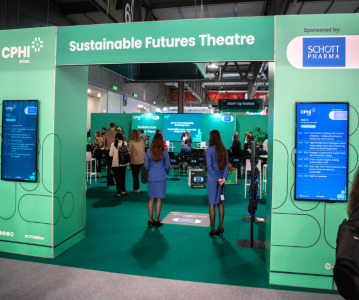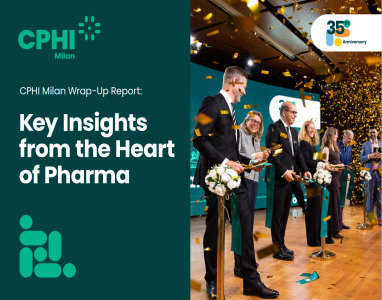CPHI Worldwide report highlights unpredictability in CDMO growth over next 5 years

Future acquisitions will not be dominated by big deals and large mergers, but rather smaller commentary services and niche technologies to fill specific technology asset gaps.
CPHI Worldwide – held in Frankfurt, 24-26 October and organised by UBM – announces the findings of Part I of the 5th edition of the CPHI Annual Report, which focuses on the immediate and long-term trends in pharmaceutical outsourcing. The exhibition, as the world’s largest pharma event, is a key bellwether of global trends and the industry’s overall strength. This first part of the report features the contributions of four industry experts – Gil Roth President, PBOA; Vivek Sharma, CEO at Piramal Pharma Solutions; BSV Prasad, Sr Vice President & Head, Small Molecules Business, Biocon; and Sam Tadayon, Executive Director & Dr Minzhang Chen, CEO at STA Pharmaceutical.
The overall findings reveal that the trend towards the integration of pharmaceutical outsourcing continues, with single source providers in terms of development increasingly sought. However, acquisitions in the future will not be dominated by big deals and large mergers, but rather smaller commentary services and niche technologies to fill specific technology asset gaps. Furthermore, the industry is anticipating a large increase in the use of flow chemistry and fermentation technologies – but resistance to change may slow adoption significantly. The new US Government administration, the longer-term implications of drug pricing, and Big Pharma income repartitions are highlighted as the key unknowns and risks for CDMO sector.
Gil Roth, President of the Pharma and Biopharma Outsourcing Association, suggests that the consolidation expected of the CMO/CDMO sector to improve the efficiency of outsourcing has not yet panned out in 2017 [this was written prior to Catalent's purchase of Cook Pharmica]. The only large merger with the intention of creating a more integrated outsourcing model was the Lonza acquisition of Capsugel. However, Roth predicts that smaller-scale buys to expand their current capabilities are far more likely by CDMOs, whereas ‘ex-US CDMOs’ may try to boost their US presence by acquiring an existing provider or an available pharma facility.
Roth explained at length the relative unpredictability of the current pharmaceutical climate, considering the unclear plans of the current US administration. For instance, there has been a keen political desire in the US to reduce drug prices, but with very little indication of policy, leaving pharma companies and 'CDMOs in the dark as to decisions that may very well disrupt their entire business model’. Another knock-on industry effect could result from a 'tax holiday' in which Big Pharma reinvests large amounts of repatriated capital in its own domestic facilities, particularly biologics sites, with negative connotations for the growing CDMO industry. He added: “Given the focus on reducing legal immigration in the US, there is additionally the strong possibility of a shift in the talent pool of pharma employees to other more welcoming nations, which may impact the domestic wages."
Vivek Sharma, CEO at Piramal Pharma Solutions, forecasts that the long-heralded one-stop-shop CDMO is now coming to fruition in the industry, with biotechs a clear beneficiary of this trend. Echoing Roth’s perspective, he argues that over the next few years we will see ‘CDMOs in niche areas forward and back integrate’, offering more integrated value chains to customers. In fact, by simplifying the supply chain, CDMOs enable VCs to have a longer runway for investments, and the potential for faster returns, while also reducing risk.
“From pharma’s perspective, this enables them to concentrate on broadening the number of drug discovery programmes they work on simultaneously and should expedite new drugs to market. In fact, over the next 2-5 years we will increasingly see more symbiotic relationships between pharma and CDMOs – with even capital and risk-sharing deals” added Sharma. He concluded that in terms of specific products classes, in the immediate future, oncology continues to grow quickly as pharma and biotech see medium-term potential success. It is, therefore, likely that CDMOs will invest in parallel areas such as high potency API manufacture, lyophilized/injectable products and antibody drug conjugation as the sector arms itself for the next wave of drug candidates.
Sam Tadayon, Executive Director & Dr Minzhang Chen, CEO at STA Pharmaceutical, state that flow chemistry has the potential to revolutionise and modernise pharmaceutical processes, but cautions that overall, the industry is still a full 50 years behind the bulk chemicals industry on the implementation of this technology. They note that implementing changes at the commercial stage can be limited by regulatory challenges. However, those companies that invest early in this technology will benefit from more environmentally friendly production, and potentially double digit cost savings at commercial scale. To expedite the process and advance the technology more quickly, an increased number of specialized chemical engineering teams will be needed. Initial development of flow chemistry production occurred at Big Pharma facilities, but increasingly, we will see these outsourced by the pioneers to their strategic CDMO partners.
“The message here is clear: for flow chemistry to deliver on its huge promise, pharma and CDMOs need to build the platform into the early-phase process R&D of innovative API programs” commented Dr Tadayon. “In the next 5 years however, more advanced flow technologies will be developed and more companies will be developing continuous processes, while the existing scientists will build up more experience in this area. As a result, we should expect a wider range of reactions to be processed through flow, and a lower bar to be established for selecting a process to be operated in flow. During this time, we expect to see more multistep flow processes performed.” Dr Chen added.
The report also pointed to the increased role fermentation is set to have in bringing newer types of drugs through the development pipeline. Biocon’s, BSV Prasad, Sr Vice President & Head, Small Molecules Business highlighted the role it will have in helping to commercialise new vaccines, biologics and even problematic areas like the creation of new antibiotics that overcome antimicrobial resistance. In particular, the technology holds the key to fully leveraging the advances in recombinant DNA and will be beneficial to drug discovery programs involving stem cells and even gene therapy vectors. The resurgence of interest in antibiotic development and therapeutic vaccines is also forecast to drive increased demand over the medium term.
Andreas Mavrommatis, Global Marketing Director at UBM EMEA: “In the last 5 years CPHI has grown its attendee base enormously, but during the same period, the event has established itself as a vital channel for industry research, analysis and trends. This year our Annual Report experts have highlighted flow chemistry, integrated CDMOs, and potential threats to outsourcing from a changing business environment. I would encourage all attendees to read a copy of the findings and also use CPHI Worldwide as a sounding board to explore how they might be able to work more efficiently, grow revenues and explore the latest development and manufacturing technologies. As well as an opportunity to meet existing customers, CPHI provides a steer on tomorrow’s developments and helps you explore the right partners to maximise the value in your business.”
Related News
-
News Closing 2024 with Editors' picks of top articles from the past year
Coming to the end of 2024 and it’s certainly been a busy year, for CPHI and for the rest of the pharmaceutical and healthcare industry. Topics of conversation throughout the last 12 months have been varied, touching on the technical, to the polit... -
News SCHOTT Pharma’s sustainable journey with CPHI
Sustainability is of paramount importance in the pharmaceutical industry. See how a recent partnership between CPHI and SCHOTT Pharma has helped to highlight and accelerate their sustainability journey to reach global goals. -
News CPHI Podcast Series: Investing in a vision for the future of life sciences
In this episode Lucy Chard is joined by Rajiv Khatau to discuss the importance of looking into new therapeutic areas and some of the more niche areas of pharmaceuticals, and investing in the future of the industry. -
News Lessons from CPHI Milan 2024: Sunny Intervals for Pharma Manufacturing?
As the 2024 CPHI conference wrapped up in Milan, we caught up with L.E.K. Consulting – a global strategy consulting firm with deep expertise in pharma manufacturing – to discuss evolving market perspectives and business outlook. -
News Women in Pharma: Reflections from Behind the Scenes
In this instalment of our monthly series, the team that brings you the Women in Pharma series each month sits down for a heart-to-heart on what the series means to them, and how they hope to continue their work in the future. -
News CPHI Milan 2024: Excerpts from the Exhibitors
After another successful year of bringing the pharmaceutical community together at CPHI Milan in October, hear direct from the exhibitors on why the event is so important for them and the industry as a whole. -
News Scaling the Industry: CPHI Scale-Up Market interview with YSK Laboratories
For the first time, CPHI Milan hosted the CPHI Start-Up Market, expanding support for emerging and small-sized enterprises in their transition to the next level of growth. In this interview, we spoke with Yuvansh Khokhani, Managing Director of YSK Labo... -
News Key Insights from the Heart of Pharma: an exclusive CPHI Online report
CPHI Milan, held from October 8–10, 2024 in the historic Fiera Milano, celebrated its 35th edition of bringing together the pharmaceutical industry and supply chain for 3 days of collaborating and innovating. Our first CPHI Wrap-Up Report brings ...
Recently Visited
Position your company at the heart of the global Pharma industry with a CPHI Online membership
-
Your products and solutions visible to thousands of visitors within the largest Pharma marketplace
-
Generate high-quality, engaged leads for your business, all year round
-
Promote your business as the industry’s thought-leader by hosting your reports, brochures and videos within your profile
-
Your company’s profile boosted at all participating CPHI events
-
An easy-to-use platform with a detailed dashboard showing your leads and performance







